![]()
![]()
![]()
Use LEFT and RIGHT arrow keys to navigate between flashcards;
Use UP and DOWN arrow keys to flip the card;
H to show hint;
A reads text to speech;
182 Cards in this Set
- Front
- Back
|
What is a disease?
|
manifestation of something going wrong
|
|
|
What is illness?
|
The patient's experience of a disease.
|
|
|
What is epidemiology?
|
The branch of medicine that deals with the study of the causes, distribution, and control of disease in populations.
|
|
|
What is endemic?
|
A disease native to a particular place or type of people.
|
|
|
What is pandemic?
|
A disease that spans the country, world or across all kinds of people.
|
|
|
What does etiology mean?
|
The study of the causes of disease, such as genetics, environment, lifestyle, etc.
|
|
|
What does neoplastic mean?
|
Tumors and cancers.
|
|
|
What is immunologic?
|
Allergies, hypersensitivities
|
|
|
What is a physical agent?
|
Something that causes damage for example, cold, bullets, knives, etc.
|
|
|
What is a nutritional disorder?
|
Lack of, or excess, of a nutrient.
|
|
|
What does latrogenic mean?
|
medicine-caused, malpractice
|
|
|
What is idiopathic?
|
Unknown cause (idiots can't figure it out)
|
|
|
What is Psychogenic?
|
Psychological condition, not necessarily hypochondriac, but could be. A medical condition could be affected by a psychological condition.
|
|
|
What is the difference between signs and symptoms?
|
Symptoms are what a patient experiences, their complaints. Signs are lab values or what a practitioner notices.
|
|
|
What is a lesion?
|
A visible tissue change.
|
|
|
What is a prodrome?
|
An infection before manifestation.
|
|
|
What is manifest?
|
Obvious or apparent
|
|
|
What are complications?
|
An adverse situation aggravating the original disease.
|
|
|
Define remission.
|
The period during which the symptoms of a disease abate or subside. Not sure if healed or not.
|
|
|
What is exacerbation?
|
To increase the severity or bitterness of a disease.
|
|
|
Define convalesce.
|
Recovering but not quite energized again.
|
|
|
What is chronic?
|
Not yet fully recovered.
|
|
|
What is pathogenesis?
|
The origin, development, and resultant effects of a disease. Predict untreated outcomes from symptoms. Ex. heart attack, cells lack oxygen, lose muscle function, etc.
|
|
|
What are implications for treatment?
|
Do we have one? Can we make them comfortable? Can we slow the progresssion? Can they manage the treatment or remember to take their medication?
|
|
|
Describe cellular injury.
|
Hurt cells will either recover or not. Sometimes they can adapt, hypertrophy (or overgrow). Liver injury can be reversible.
|
|
|
What are the areas of weakness in cell injury?
|
Cell membranes, DNA damage and a decrease in ATP production (which increases risk of cell death).
|
|
|
What are the main ways to injure cells?
|
Ischemia/ hypoxia and Free radicals.
|
|
|
What is ischemia or hypoxia?
|
Ischemia is a local defiency of blood supply and hypoxia is a general lack of oxygen in the blood. Some damage is reversible and some is not.
|
|
|
What is a reversible change of ischemia or hypoxia?
|
An increase in lactic acid leads to an increase in acidity so a decrease in ATP is made. A decrease in ATP leads a decrease in the Na+/ K+ pump action and cells swell and decrease function. Ribosomes then fall off the ER, decreasing protein synthesis.
|
|
|
What is a non-reversible change resulting from ischemia or hypoxia?
|
When lysosomes rupture and cell contents are digested. There is an increase in calcium from outside the cell, the smooth ER or the mitochondria. It activates enzymes that cause cell membrane damage, DNA damage and free radicals are created.
|
|
|
What are free radicals?
|
Molecules that have an unbalanced number of ions. They are very aggressive and will damage any molecule.
|
|
|
What are free radicals created by?
|
- high energy, x-rays, radiation, UV light
- metabolism – especially high metabolism - lack of or return of oxygen - certain chemicals – carbon tetrochloride (used for dry- cleaning) |
|
|
What protects cells from free radicals?
|
Peroxidase and superoxide dismutase
|
|
|
What is necrosis?
|
Pathological cell death. Tissue loss and inflammation.
|
|
|
What are the different kinds of necrosis?
|
1. Coagulative
2. Gangrene 3. Liquefactive 4. Caseous |
|
|
Describe coagulative necrosis.
|
Dry and holding. Histology looks okay for a few days. There is increased WBCs and it usually follows ischemia.
|
|
|
Describe Gangrene necrosis.
|
Typically happens on a limb that has a lack of oxygen and becomes infected. Also called gas gangrene.
|
|
|
Describe caseous necrosis.
|
"Cheesy", usually in TB patients, it is liquifactive in a connective tissue capsule.
|
|
|
Describe liquefactive necrosis.
|
Slime, caused by either infection with WBCs or lack of oxygen to the brain.
|
|
|
What is apoptosis?
|
Programmed cell death. Can be triggered by a loss of hormones, or tumor necrosis factor. No inflammation.
|
|
|
What is tumor necrosis factor?
|
The cells kill itself to save the body, or when the body is being formed, the opposite sex cells die off (or example may be webbing between fingers cells die).
|
|
|
What are injury responses at the cellular level?
|
1. Intracellular defense
2. Inflammation 3. Endocytic cells 4. Other White blood cells 5. Scar formation 6. Metaplasia |
|
|
Describe intracellular defense.
|
1.Complement response - react to antibody/ antigen complexes
2. trigger inflammation 3. opsonize (help with endocytosis) 4. lyse the antigen (if it's a cell) |
|
|
What triggers inflammation?
|
1. Toxins
2. The rupture of cells 3. The complement reaction 4. Exocytosis by basophils, if in blood, or mast cells, if in tissue 5. Cytokines 6. Interleukins. |
|
|
Describe inflammation.
|
1. Increase in capillary permeability.
2. Vasodilation (warm and pink) 3. Block lymphatics - traps infection and causes edema 4. Recruit WBCs & fibroblasts (which create scar tissue) |
|
|
Name the endocytic cells.
|
1. Eosinophils - works on allergies & parasites - anything with IgE
2. neutrophils - in blood 3. macrophages - other tissues 4. dendritic cells - in the epidermis (hives, rashes, etc.) |
|
|
What other kinds of white blood cells are there?
|
T- lymphocytes
Natural killer cells B- cells |
|
|
Describe T-lymphocytes.
|
They are specific and there are 2 different kinds:
CD4 - helper t-cells that release interleukins and increase activity of the immune response. CD8 - cytotoxic t-cells which bind to and kill cells that have an antigen. |
|
|
Describe natural killer cells.
|
They are in all tissues. They target "altered" self - majorhistocompatability complex (MHC). They attack virus infections and cancers, they lyse cells and they are always active.
|
|
|
Describe B-cells.
|
They are in lymph tissues (peyer's patches, lymph nodes, tonsils, spleen). They make and release antibodies when activated. There are 4 types.
|
|
|
What types of B cells are there and describe them.
|
Immunoglobulins G,A,M & E
IgG - small, can travel anywhere (General) IgA - in secretions such as sweat, semen, breast milk (AAAA - baby cries for breastmilk) IgM - big, in blood and lymphatic fluid only (Macro) IgE - carried by basophils and mast cells - deals with pregnancy, parasites & allergies (EEEEK! It itches!!) |
|
|
Describe Scar formation.
|
Strong tissue created by fibroblasts that lay down collagen and other EC matrix produts. Allows for regrowth of epithelia, blood vessels, nerves, etc.
|
|
|
Describe metaplasia.
|
When, during repair, the tissue is changed from one kind to another. Example, muscle tissue is replaced with Dense irregular connective tissue or bone.
|
|
|
What is a genetic mutation and what kinds are there?
|
A change in DNA code. Autosomal dominant, autosomal recessive and X-linked recessive.
|
|
|
Name some autosomal dominant mutations.
|
Achondroplasia - "little people"
Marfans syndrome - extra tall people, with long fingers, weakened hearts, and often detached eye lenses. Familial hypercholesterolemia - high blood cholesterol |
|
|
Name a couple of autosomal recessive mutations.
|
Cystic Fibrosis - thick mucous
Sickle cell anemia - crescent shapes RBCs |
|
|
Name a couple of X-linked recessive mutations.
|
Duchenne's Muscular Dystrophy
Hemophilia A |
|
|
What are chromosomal mutation?
|
When a portion of the chromosome is missing or deleted.
|
|
|
What is the chromosomal mutation "mosaic"?
|
More than one genotype expressed in someone developed from one fertilized egg. An example could be someone who has 2 different colored eyes.
|
|
|
What is the chromosomal mutation "chimera"?
|
Two embryos fused into one individual, for example a woman, during formation, absorbed her non-identical twin and got her ovaries.
|
|
|
What is Trisomy 21?
|
The chromosomal disorder Down Syndrome characterized by low muscle tone, enlarged tongue, Asian eyes and learning disabilities.
|
|
|
What is Klinefelter's?
|
A chromosomal disorder with a male with an extra X chromosome - XXY or XXXY. Puberty may be delayed and they may be infertile.
|
|
|
What is Turner's syndrome?
|
A chromosomal disorder where the female is missing the second X chromosome. X_. 90% of these babies will be miscarried and those born will be petite with hand and neck edema, webbed neck, low hairline, infertility and delayed, or no, puberty.
|
|
|
What is Cri Du Chat?
|
A chromosomal disorder where part of chromosome 5 is missing. It is characterized by low set ears, round head, a cry like a cat instead of a baby, Asian looking eyes, heart defects and severe mental challenges.
|
|
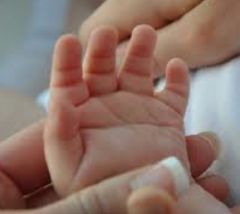
What is possible about this baby?
|
The baby most likely has Down Syndrome, which is characterized by a single line across the palm.
|
|
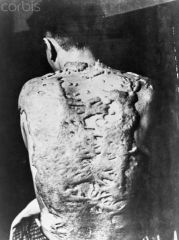
What are these scars called?
|
Keloid scarring.
|
|
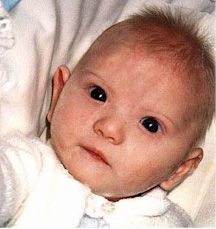
Do you recognize what this baby could possibly have?
|
Cri Du Chat, characterized by the low set ears and round head.
|
|

What kind of mutation is this?
|
Insertion mutation.
|
|

What kind of mutation is this? What does CF stand for in this particular mutation?
|
It is a deletion mutation and CF here stands for Cystic Fibrosis.
|
|
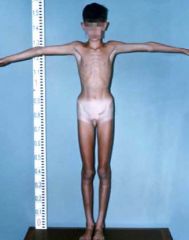
This may be hard to see, but it is a photo of an older boy. He has no body hair. What could be wrong with this boy? What kind of chromosomal disorder is it?
|
Klinefelter's syndrome. It is characterized by an XXY chromosomal disorder. He may be infertile as well.
|
|
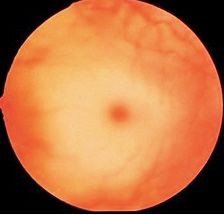
What is this a picture of and where is it typically seen?
|
This is a red spot on the retina of the eye in children with Tay-Sachs.
|
|
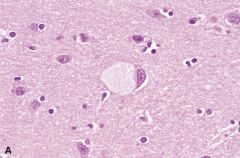
What is this a picture of?
|
Lipid storage in the brain of a Tay-Sachs patient.
|
|
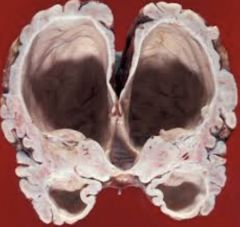
What is this a picture of?
|
A postmortem brain of a patient with hydrocephalus.
|
|
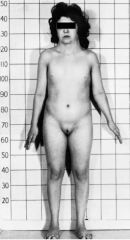
What may be wrong with this lady? It may be hard to see, but she lacks breasts, body hair and appears to have a webbed neck.
|
Turner's Syndrome.
|
|
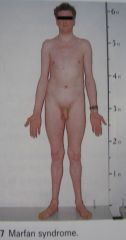
What could be wrong with this man? It may be hard to see, but he's very tall and has long appendages.
|
Marfans.
|
|
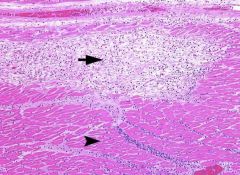
What is this a photo of?
|
A slide of cardiac tissue, post MI inflammation. (Myocardial infarction).
|
|
|
What is epigenetics?
|
The study of the way in which the expression of heritable traits is modified by environmental influences or other mechanisms without a change to the DNA sequence.
|
|
|
What is teratology?
|
The study of abnormal formations in organisms (monstrosities).
|
|
|
What are congenital disorders?
|
Disorders that happen during fetal development and present at birth.
|
|
|
In what trimester would a change from the norm be most drastic at birth?
|
The first trimester.
|
|
|
What is a teratogen?
|
A drug or other substance capable of interfering with the development of a fetus, causing birth defects.
|
|
|
Name some teratogens.
|
1. Chemicals or medicines
2. Alcohol (Fetal Alcohol syndrome) 3. Accutane - acne medication that causes birth defects 4. Thalidomide - a medication to prevent miscarriage that causes birth defects. 5. Radiation - causes DNA damage & free radicals 6. Infections |
|
|
What infections are teratogens?
|
Syphilis
chicken pox T-toxoplasmosis O- other R- rubella can cause male infertility or deafness C - cytomegalovirus H-Herpes - goes to the brain and nervous system |
|
|
What else can be a teratogen?
|
A nutritional disorder of the mom. Vitamin A deficiency can cause eye problems for the fetus and Folic Acid can cause neural tube defects (like spina bifida).
|
|
|
What is neoplasia?
|
Tumor growth.
|
|
|
What does Onco mean?
|
Abnormal growth?
|
|
|
What does benign mean?
|
Not bad or not causing trouble.
|
|
|
What is a tumor?
|
A specific lesion, area of abnormal growth, easily identifiable.
|
|
|
What does malignant mean?
|
Bad, spreading throughout the body. Mal - bad. The cells lose contact inhibition (will divide even when surrounded).
|
|
|
What is cancer?
|
A malignant tumor.
|
|
|
What is an adenoma?
|
Benign epithelial growth.
|
|
|
What is Adenocarcinoma? Give an example.
|
Malignant growth. Breast cancer is an example.
|
|
|
What is a cyst?
|
Hollow ball of cells with fluid inside. Could be benign or malignant.
|
|
|
What is a papilloma?
|
A wart, skin or genital.
|
|
|
What is a sarcoma?
|
Has a mesoderm origin. A growth in the muscle or bone. Always malignant.
|
|
|
What is a teratoma?
|
A tumor or group of tumors composed of tissue foreign to the site of growth. Sometimes has teeth or hair.
|
|
|
What is metastases?
|
Multiple malignant neoplasia.
|
|
|
For cell differentiation, what is "differentiated"?
|
They look relatively normal, for epithelia, they're typically benign, for other tissues they could be malignant.
|
|
|
For cell differentiation, what is "dis-plastic"?
|
Weird but identifiable. A pap smear is an example.
|
|
|
For cell differentiation, what is "anaplastic"?
|
Always bad, unidentifiable.
|
|
|
How is staging determined?
|
1. Tumor size
2. Metastases or not 3. How far is it differentiated from original tumor 4. Wether is it encapsulated in a connective tissue capsule. |
|
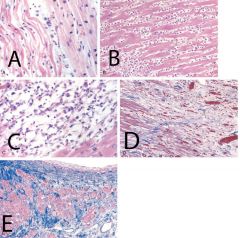
What does this slide show and what is A?
|
The steps to scar formation. A is inflammation.
|
|

What is B?
|
Coagulative necrosis.
|
|
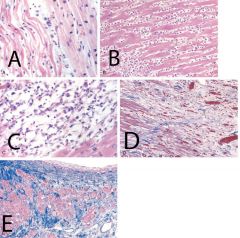
What is C?
|
Dead tissue being removed.
|
|

What is D?
|
Scarring beginning.
|
|
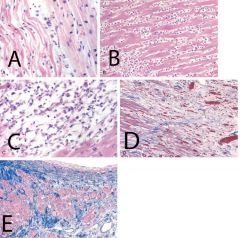
What is E?
|
Scar tissue.
|
|
|
What is etiology?
|
The study of the cause of disease.
|
|
|
What are oncogenes?
|
Genetic causes for cancer if not functioning properly.
|
|
|
What kinds of oncogenes are there?
|
1. Proto-oncogene
2. Suppressor genes 3. Apoptosis genes 4. DNA repair genes 5. Free radical response/ removal gene |
|
|
What is a proto-oncogene?
|
A developmental growth gene that's turned off after puberty.
|
|
|
What is a suppressor gene?
|
A gene that turns off a proto-oncogene.
|
|
|
What are apoptosis genes?
|
Genes that cause cell suicide. WBCs trigger the tumor necrosis factor.
|
|
|
What are DNA repair genes?
|
Genes to fix radiation and free radical damage.
|
|
|
What are free radical response/ removal genes?
|
Genes to help remove free radicals. Superoxide dismutase is needed (superoxidase).
|
|
|
What are some causes of cancer?
|
Oncogenes
Viruses The Environment (chemical carcinogenesis). |
|
|
How do viruses cause cancer?
|
Blocking a gene by inserting into that location or
Imitating a gene and turning a cell into a growth factor factory. |
|
|
Name some viruses that can cause cancer.
|
The human papilloma virus (HPV) causes warts but can also cause cervical cancer, oral & throat cancer, rectile and penile cancer. The hepatitis C virus can cause liver cancer. The Epstein-Barr virus can cause lymphomas.
|
|
|
What is chemical carcinogenesis?
|
The environment - An initiator , a promoter or a growth factor/ hormone initiator.
|
|
|
What is an initiator?
|
A DNA damage inducer in the environment.
|
|
|
What is a promoter?
|
Something in the environment to trigger cell division before DNA can be repaired. An example would be of the uranium coal miners that smoked got cancer quicker.
|
|
|
What is a growth factor/ hormone initiator?
|
Something in the environment that causes insulin resistance or increases estrogen causing cancer. Examples include plastic additives, phthalates, bisphenol and fire retardents.
|
|
|
What are some clinical manifestations of cancer?
|
Cachexia
Pain Bone marrow suppression Ectopic hormones Ascites Hypercalcemia. |
|
|
What is cachexia?
|
Significant weight & protein loss.
|
|
|
Does cancer hurt?
|
Typically, pain from cancer is pressure from the growth on surrounding tissue. The cancer itself doesn't hurt.
|
|
|
What does paraneoplastic mean?
|
A symptom that is a consequence of cancer in the body.
|
|
|
What is bone marrow suppression?
|
Decreased immunity and anemia from internal bleeding.
|
|
|
What are ectopic hormones?
|
Hormones in the wrong place.
|
|
|
What is ascites?
|
Fluid in the abdomen after metasteses.
|
|
|
What is hypercalcemia?
|
High blood calcium, Excess PTH (parathyroid hormone) or bone invasion.
|
|
|
How do hormone related cancer treatments work?
|
A. block the hormones or remove the growth factors
B. block the receptors for the growth hormone C. block the signal pathway within cancer cells |
|
|
What are some non-hormone related cancer treatments?
|
1.Block blood supply/ food to the cancer cells
2. photodynamic 3. Using the immune system 4. Disrupting cell division |
|
|
What is photodynamic?
|
A targeted dye and tuned-light laser to kill cancer cells
|
|
|
How is the immune system used to treat cancer?
|
Making antibodies specific to the tumor increasing the immune reaction to the cancer and/ or binding a chemo drug to the antibody - "targeted chemo".
|
|
|
How do you disrupt cell division of cancer cells?
|
Damage the DNA with radiation or damage the microtubules.
|
|
|
What immune conditions are there?
|
1. Hypersensitivities
2. Immune Deficiencies 3. Major Autoimmune disorders |
|
|
What are hypersensitivities?
|
Normal immune functions taken too far. There are 4 types.
Type I - Allergic or anaphylactic Type II - Cytotoxic or cytolytic (antibody mediated) Type III - Immune Complex mediated Type IV - Delayed hypersensitivity |
|
|
Describe type I hypersensitivity and give examples.
|
Allergic or anaphylactic. There is an immediate reaction. There are IgE on basophils or mast cells, which triggers inflammation and swelling and eosinophils. Examples include dermatitis, hives, anaphylaxis, and allergic rhinitis (runny nose).
|
|
|
Describe type II hypersensitivity and give examples.
|
Cytotoxic or cytolytic - antibody mediated. Response happens in hours. Involves IgG and IgM. The antibodies bind to the antigens. Involves the MHC protein, natural killer cells, complement proteins, macrophages, neutrophils and endocytosis. An example would be a reaction to wrong blood in a transfusion, organ rejection, graft vs. host, type I diabetes, or Addison's disease.
|
|
|
Describe type III hypersensitivity and give examples.
|
Immune complex mediated. Reaction appears in a day. Involves IgG, which binds to the antigen. Often happens post infection. Macrophage, complement and neutrophils (immune complex) get stuck in the tissues. Normal cells get lysed and antibodies are made to normal cell contents - anti-nuclear antibodies (ANAs). Common places are kidneys, small arteries and joints. Example would be rheumatoid arthritis, sarcedosis, scleraderma and reynaud's complex.
|
|
|
Describe type IV hypersensitivity.
|
Delayed hypersensitivity. Takes 1-3 days to trigger. It it T-cell mediated. The T-cells are sensitized. Helper T-cells get recruited. Macrophages make a "nest" and look like epithelia (a granuloma- an inflamed lump - has a good blood supply). Fibroblasts get encased with a scar. The TB lesion test - the lesions are granulomas. MS lesions are granulomas.
|
|
|
What is Reynaud's complex?
|
When hands are exposed to the cold, the vessels in the hands constrict to the point of making the hands turn white, then blue. They don't respond right away when returned to warmth, then flush and turn red. (Red, white and blue)
|
|
|
What kind of immune deficiencies are there?
|
Genetic and Infection.
|
|
|
Explain genetic immune deficiency.
|
There are two kinds.
A. Severe Combined Immunodeficiency (SCID) where there are no B-cells or T-cells (like the boy in the bubble). B. X-linked Agammaglobulinemia which typically affects boys. There are no IgGs, no B-cells, lymph nodes are flat, small spleen. They will get IgG from mother's milk until weened. |
|
|
Describe infection immune diseases.
|
There are also 2 kinds. The Epstein-Barr virus which causes Mononucleosis. Mono is characterized by fever, swollen lymph nodes, transmitted by saliva, will often get secondary infections and will have hepatomegaly and splenomegaly. In the blood there is a high count of lymphocytes that are swollen and look like weird monocytes (thus, the name).
|
|
|
What is a swollen liver called?
|
Hepatomegaly.
|
|
|
What is a swollen spleen called?
|
Splenomegaly.
|
|
|
What is lymphadenitis?
|
Painful lymph nodes.
|
|
|
What is lymphadenopathy?
|
Swollen lymph nodes.
|
|
|
Explain infection immune deficiency.
|
Aids is acquired immune deficiency. It is caused by the Human Immunodeficiency virus. When the immune system is okay with the HIV virus, the body is constantly replacing CD4 cells and the Natural Killer are removing infected cells. AIDS happens when the T-cell numbers drop and infections and cancers start happening.
|
|
|
Explain Major Autoimmune Disorders.
|
There are 4 kinds. Siogren's, Systemic Lupus Erythromatosis, Rheumatoid Arthritis and systemic sclerosis. All 4 are type III hypersensitivity.
|
|
|
Explain Siogren's.
|
High # of ANAs, high erythrocyte sedentation rate (SED), targets lacrimal glands, salivary glands, mucous membranes, so dry eyes, dry mouth, dry lungs, dry genitals, sometimes rheumatoid arthritis symptoms (RA).
|
|
|
What is the name for "dry mouth"?
|
Xerostoma.
|
|
|
Explain Systemic Lupus Erythromatosis.
|
Named for a malar rash on the face. Anemia is common. Sometimes includes discoid lupus, which only involves the skin. 2/3 patients are women between 15 & 35 years with highest risk for Hawaiian, Asians, Native Americans and African-Americans. Apoptosis doesn't seem to work right. Can find antibodies to blood cell proteins. Fatigue, fever, joint pain, rashes, photosensitive skin. Often takes 5 years to diagnose. Kidney inflammation (50% failure). Pericarditis (fluid buildup around the heart) is common. Treatment includes ant-malaria drugs and chemo.
|
|
|
Explain Rheumatoid arthritis.
|
More common in women in their teens to 20s. Can be post-infection or following another autoimmune disease. Typically involves the smaller joints. Low fever with joint pain. In blood, rheumatoid factor if definitely found and sometimes ANAs are found. Often inflamed nodules near the joint. Treatment includes corticosteroids and anti-necrosis factor meds.
|
|
|
What's the difference between Osteoarthritis and Rheumatoid arthritis?
|
RA usually involves the smaller joints and Osteoarthritis usually involves weight-bearing joints.
|
|
|
What are the layers of the adrenal gland and where is it located?
|
The medulla is the innermost layer and the adrenal cortex is the outer section. It sits on top of the kidneys.
|
|
|
What are the layers of the adrenal cortex?
|
The glumerular layer is the outermost layer, the fascicular layer is the middle portion and the reticular layer is the innermost layer.
|
|
|
What happens in the glomerular layer of the adrenal cortex during stress.
|
It produces aldosterone which goes to the kidneys. Causes the kidneys to retain sodium and water but lose potassium, which raises blood pressure.
|
|
|
What happens with the fascicular layer during stress?
|
The middle layer of the cortex, It produces cortisone, which goes to the liver and releases glycogen as glucose, raising the sugar levels in blood. It also encourages the liver to convert amino acids and lipids as glucose and acetyl groups, also causing a rise in blood sugar. Cortisone also goes to the bone marrow and reduces WBC production and activity increasing the chances of infection and illness.
|
|
|
What happens in the reticular layer of the adrenal gland during stress?
|
The innermost layer of the cortex (next to the medulla) makes estrogen and androgen. Women may grow facial hair due to the excess androgen, and with enough stress, men may grow "man boobs" because of the excess estrogen.
|
|

What is this a picture of?
|
It is a histology slide of granulomas in a lymph node. The large pink circles that take up the center of the slide are the granulomas.
|
|
|
Explain systemic sclerosis.
|
It is an autoimmune disease affecting the connective tissues of the whole body. Scleroderma is the form that only affects the skin. Affects more women than men, usually over the age of 25, is progressive, affects all races and countries, increases antibodies, affects the arteries and arterioles, increasing the smooth muscle, reducing the size of the lumen, causing ischemia, inflammation, necrosis and fibrosis. Atherosclerosis is common and digestive strictures. Some will have fatal kidney scarring.
|
|
|
What is the treatment for systemic sclerosis?
|
Anti-inflammatories, immune suppressing drugs, anti-fibrotics (anti-scarring) drugs, and possibly stem cell experimental treatments.
|
|
|
What is leukocytosis?
|
Excess WBCs. It is a response to infection or inflammation. There are 4 kinds.
1. Polymorphonuclear leukocytosis 2. Eosinophils 3. Monocytic Leukocytosis 4. Lymphocytosis |
|
|
Explain Polymorphonuclear Leukocytosis.
|
Too many neutrophils in the blood. It is typically a response to a bacterial infection.
|
|
|
Explain eosinophil leukocytosis.
|
This is a response to allergies, parasites and pregnancy and Rheumatoid Arthritis.
|
|
|
Explain monocytic leukocytosis.
|
It is chronic inflammation, chronic infection.
|
|
|
Explain lymphocytosis.
|
It is an excess of T-cells. Typically it is a response to viral infections, including Mono (the Epstein-Barr Virus)
|
|
|
What is Leukopenia?
|
Not enough WBCs. Low count of leukocytes, possible fever. Three kinds.
1. Pseudoleukopenia 2. Lymphopenia 3. Neutropenia |
|
|
Describe pseudoleukopenia.
|
When all the leukocytes went to the site of a new bad infection. An example would be early appendicitis.
|
|
|
Describe Lymphopenia.
|
This is a lack of lymphocytes. This is typically from genetic deficiencies.
|
|
|
Describe Neutropenia.
|
It is a lack of neutrophils. It is a result of aplastic anemia such as bone marrow collapse caused by radiation, high levels of cortisone, autoimmune attack, or vitamin deficiency (B12 or folate). There are low oxygen levels, fevers, high risk of bacterial infections, lack of platelets, strep and oral ulcers with green-grey fuzzy film.
|
|
|
What is White Blood Cell Neoplasm?
|
Mature malignant lymphomas, including Hodgkins and non-Hodgkins Lymphomas.
|
|
|
Describe Hodgkins lymphoma.
|
Higher risk in young men or those exposed to agent orange, or have used growth hormones. Typically there is lymphadinopathy with no pain, but associated with fever, nightsweats, cachexia and anemia.
|
|
|
What is the treatment of Hodgkins lymphoma?
|
Chemo and radiation of dividing cells. It has a 90% cure if stage 1 or 2. With relapse, usually a bone marrow transplant is performed.
|
|
|
Describe Non-Hodgkins Lymphoma.
|
It is idiopathic. Middle to late adulthood. It is a group of about 70 different lymphomas. They all have similar symptoms in the beginning. Starts in lymph tissue such as tonsil, lymph node, peyer's patch or bone marrow, then spreads to other tissues and other parts of the body. It makes rubbery masses that will block structures or arteries. The survival rate depends on the type.
|
|
|
What treatment is used for Non-Hodgkins lymphoma.
|
Surgery, chemo, radiation.
|
|
|
What is Duchenne's Muscular Dystrophy?
|
A recessive X-linked form of muscular dystrophy, which results in muscular degeneration and eventually death. It is caused by a lack of dystrophin that the body cannot make in sufficient supply.
|
|
|
What is creatine phosphokinase?
|
An enzyme found mostly in the heart, brain and skeletal muscle. It helps to catalyze creatine which aids in bringing energy to muscle tissue. An elevated level in blood indicates damage to muscle tissue.
|
|
|
What is the pathogenesis of Duchenne's Muscular Dystrophy?
|
Symptoms usually appear between 1 and 6 years of age. Start walking late, about 18 months, have an unusual gait, muscle weakness causes a need for braces by middle school and a wheelchair by highschool. Skeletal abnormalities are common. Cardiomyopathy occurs in most cases and combined with breathing difficulties by age 18, death occurs around the age of 40.
|
|
|
What is the treatment for DMD?
|
There is no cure, but steroid medications and physical therapy often help to prolong walking ability. Respiratory devices aid in breathing. Treatment focuses on quality of life.
|
|
|
What is dystrophin?
|
A protein that is necessary for the proper functioning of muscle fibers. Without it, the muscle cells break open spilling their contents into the blood, including creatine phoshpokinase.
|

